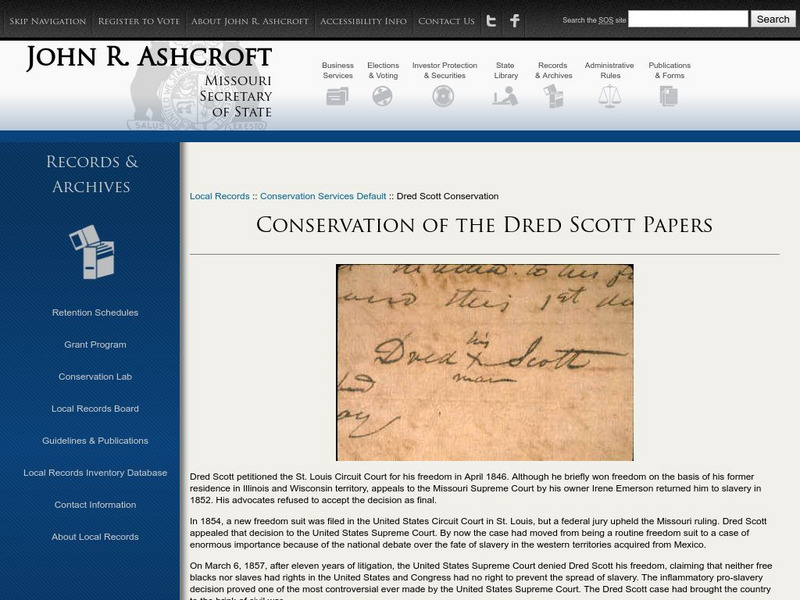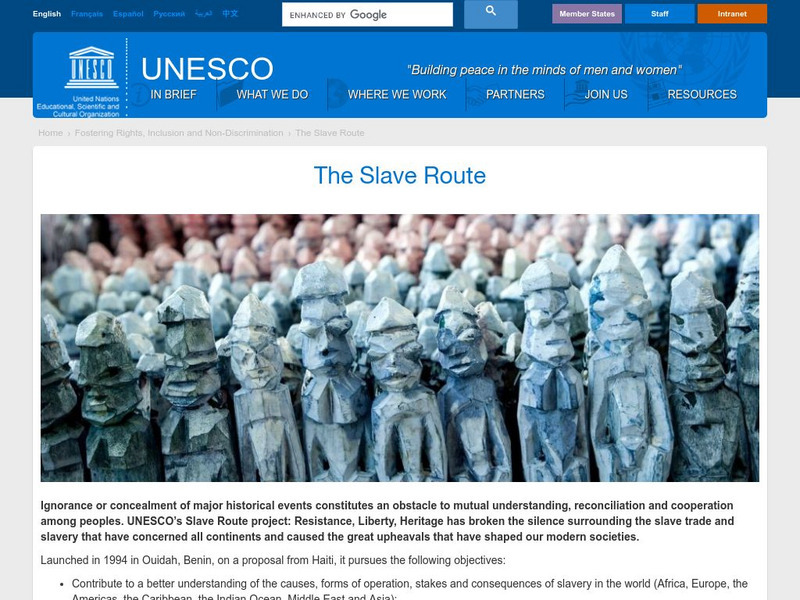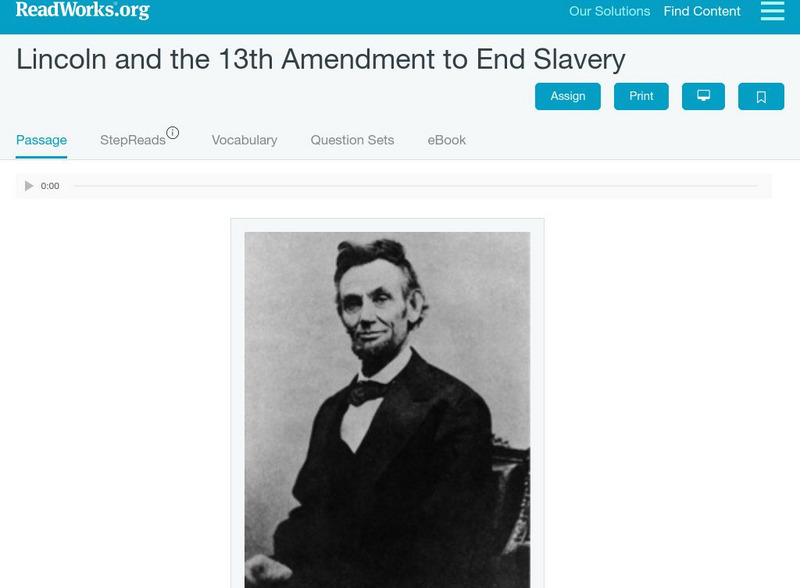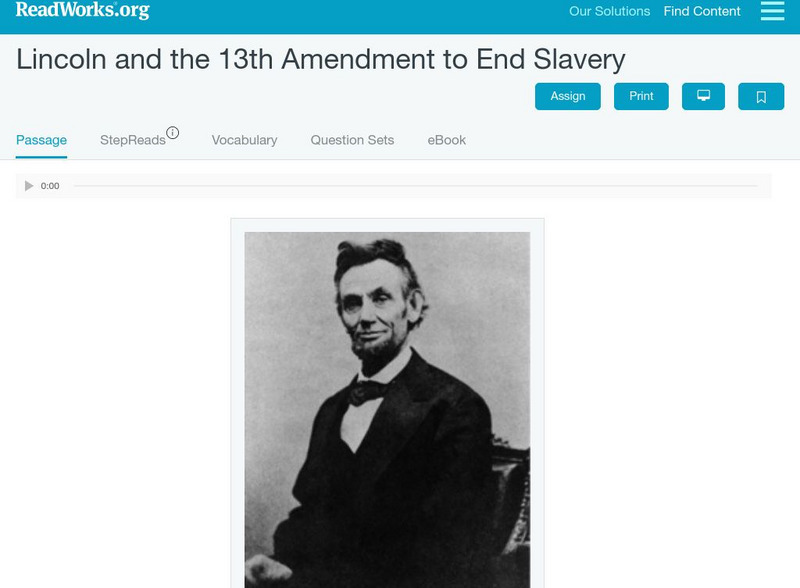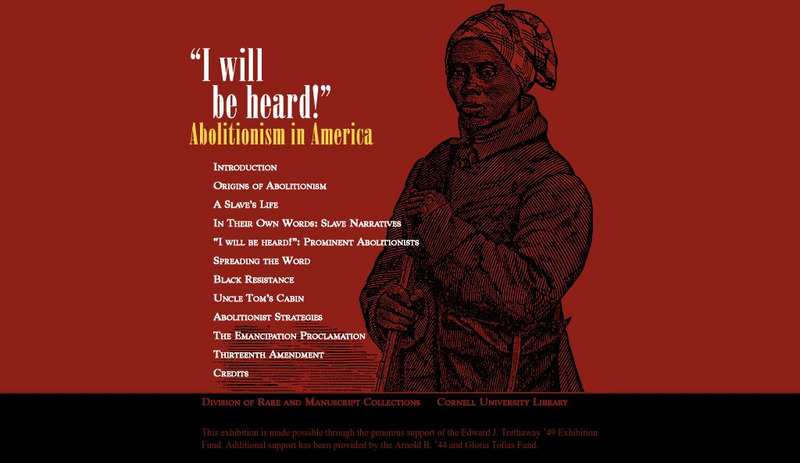Khan Academy
Khan Academy: Ap Us History: 1844 1877: The Civil War: Emancipation Proclamation
Discusses the background to the Emancipation Proclamation and how Abraham Lincoln came to support the abolition of slavery and the difficulties that were encountered around this issue. Explains that it did not apply to all slaves as...
PBS
Pbs Learning Media: Harriet Tubman: Abolition Activist
In this lesson plan, by examining two primary sources and watching a short video, students will become familiar with the remarkable bravery and extraordinary accomplishments of the "Moses of her people," Harriet Tubman.
US National Archives
Nara: Treasures of Congress: Struggles Over Slavery the "Gag" Rule
This National Archives and Records Administration site contains John Quincy Adams' response to the "gag" rule in the House of Representatives, May 25, 1836, which restricted discussion about slavery in Congress . Also included are images...
University of Wisconsin
University of Wisconsin: Carl Schurz
A selection of German-American statesman and military leader Carl Schurz' writings on his life and "True Americanism".
Other
Missouri Secretary of State: Conservation of the Dred Scott Papers
Offers a description of the conservation of papers from the famous 1846 Supreme Court case in which a slave named Dred Scott asked the court for his freedom and was denied.
US Senate
Historical Minutes: Gag Rule: March 16, 1836
A look at how the Senate in 1836 imposed a gag rule on petitions that advocated the abolition of slavery. Information is from "Arguing about Slavery" by William Lee Miller.
National Constitution Center
National Constitution Center: Thirteenth Amendment [Pdf]
Primary source document, informational text and questions for discussion included for students studying issues surrounding the abolition of slavery and the 13th Amendment to the Constitution.
Columbia University
Columbia University: Columbia University & Slavery 7. Columbia Faculty
This website was created by faculty, students, and staff to publicly present information about Columbia's historical connections to the institution of slavery. This article discusses the connection between Columbia's faculty to slavery....
Khan Academy
Khan Academy: Us History: 1844 1877: Failure of Reconstruction
The abolition movement sought to end the practice of slavery in the United States.
United Nations
Unesco: The Slave Route
An excellent set of resources on slavery and the slave trade. Looks at artists' perceptions, interviews with historians and others, the Transatlantic Slave Trade, trade in the Indian Ocean, resistance and abolition, trade in the...
Read Works
Read Works: Lincoln and the 13th Amendment to End Slavery
[Free Registration/Login Required] Students read about President Abraham Lincoln and his struggle to get the 13th Amendment passed in order to end slavery. A question sheet is available to help students build skills in reading...
The History Cat
The History Cat: The Abolitionists
Describes the abolitionist movement and the people who pushed for the abolition of slavery, especially William Lloyd Garrison who founded the Liberator newspaper and the New England Anti-Slavery Society. Arguments for slavery were put...
Cornell University
Cornell University: Library: I Will Be Heard: The 13th Amendment
Read the text of the 13th Amendment, adopted in January, 1865, even before the end of the Civil War, which ended slavery in the United States. Click on the image to see a larger picture of the document itself.
US National Archives
Nara: The d.c. Emancipation Act
Information about, and a scanned copy of page one and five, of the D.C. Emancipation Act which freed slaves in Washington, D.C. in 1862.
US Government Publishing Office
Ben's Guide to u.s. Government: Emancipation Proclamation 1863
Ben's Guide is a fun way to present U.S. Government to students grades K-12. This site presents a brief overview of the Emancipation Proclamation. Includes the transcript of the document. Links to related sites are available.
Library of Congress
Loc: Elizabeth Cady Stanton Papers
The papers of suffragist, reformer, and feminist theorist Elizabeth Cady Stanton cover the years 1814 to 1946, with most of the material concentrated between 1840 and 1902. Consisting of approximately 1,000 items, the collection contains...
Read Works
Read Works: Lincoln and the 13th Amendment to End Slavery
[Free Registration/Login Required] This ReadWorks passage provides a brief history of the official end to slavery in America, the 13th Amendment. A paired passage is part of this module, along with a lower level passage with related...
Thomson Reuters
Find Law: u.s. Constitution: Thirteenth Amendment
Presents the Thirteenth Amendment - Slavery and Involuntary Servitude, which abolished slavery and forced servitude in the United States. Includes four annotations to the Amendment.
Columbia University
Columbia University: Columbia University & Slavery 8. Columbia and Colonization
This website was created by faculty, students, and staff to publicly present information about Columbia's historical connections to the institution of slavery. Columbians played a prominent role in the New York Auxiliary Colonization...
Annenberg Foundation
Annenberg Learner: The Events of 1831: Interactive Timeline
This interactive timeline helps you examine how some of the events of 1831 were related. Significant events include slavery, abolition, evangelical revivalism, and new inventions.
Read Works
Read Works: Frederick Douglass: From Slavery to Freedom
[Free Registration/Login Required] This ReadWorks passage provides a brief biography of the abolitionist writer and speaker, Frederick Douglass. A paired passage, a vocabulary support sheet, a questions sheet, and an answers sheets are...
E Reading Worksheets
E Reading Worksheets: Narrative of the Life of Frederick Douglass
In this learning module, students will engage in a deep study of Narrative of the Life of Frederick Douglass. Worksheets, that assess reading comprehension and inferencing skills, and map projects are provided to reinforce Fredick...
Other
Online Archive of 19th Century u.s. Women's Writings: Emancipated Slaveholders
Writing in the 1840s, Lydia M. Child tells the story of ex-slavers living in Virginia. Demonstrates the complexity of the abolition debate in Pre-Civil War America.
Cornell University
Cornell University: Library: I Will Be Heard! Abolitionism in America
A collection of original manuscripts, letters, photographs, rare books, and other materials on abolitionism from the 1700s through 1865.



